Corporate Accounting Report: Funds Sourcing, Liabilities, and AASB 137
VerifiedAdded on 2022/08/23
|22
|4302
|17
Report
AI Summary
This report provides a detailed analysis of corporate accounting practices, focusing on the funds sourcing strategies of Boral Limited and Brickworks Limited, both operating in the materials sector. The study explores the internal and external sources of funds, including equity, retained earnings, loans, borrowings, and trade credit, evaluating their respective advantages and disadvantages. It examines the changes in these funding sources over a three-year period, supported by financial data. Furthermore, the report assesses the application of AASB 137, provisions, contingent liabilities, and contingent assets, to these companies. The analysis extends to the classification of assets and liabilities, specifically highlighting interest-bearing liabilities. The report also delves into the measurement basis for different asset types reported in the financial statements, offering a comprehensive overview of corporate financial management.
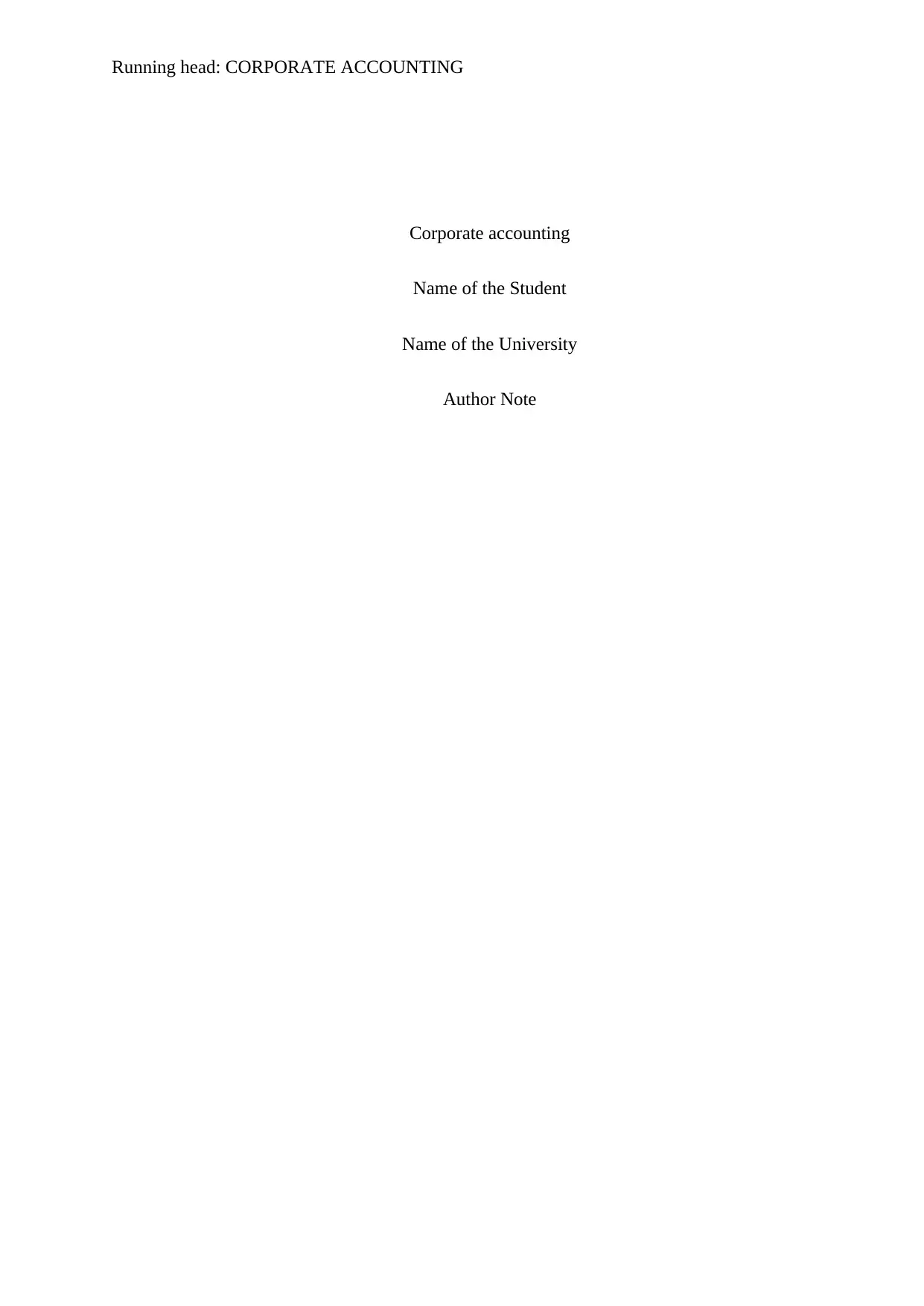
Running head: CORPORATE ACCOUNTING
Corporate accounting
Name of the Student
Name of the University
Author Note
Corporate accounting
Name of the Student
Name of the University
Author Note
Paraphrase This Document
Need a fresh take? Get an instant paraphrase of this document with our AI Paraphraser
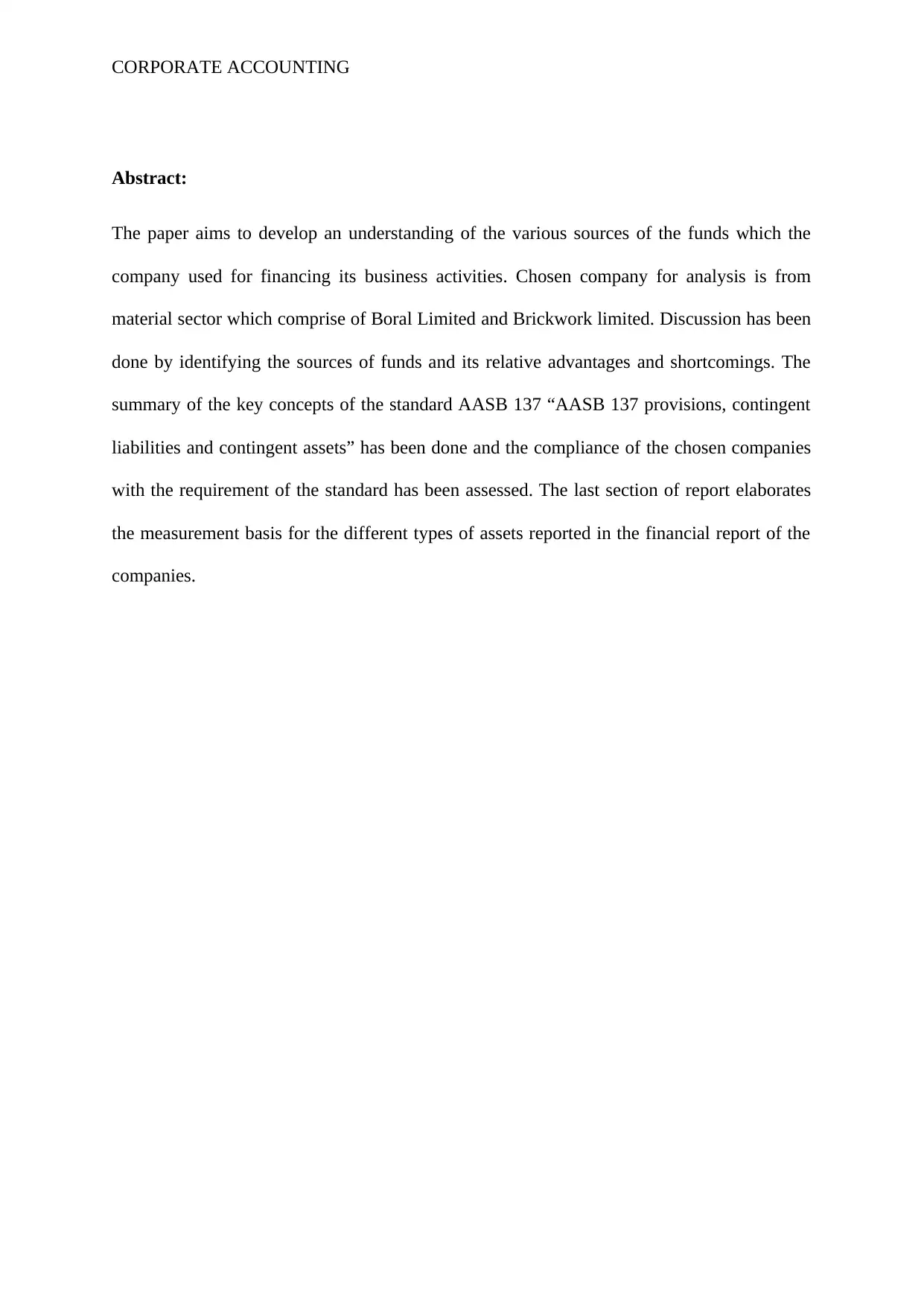
CORPORATE ACCOUNTING
Abstract:
The paper aims to develop an understanding of the various sources of the funds which the
company used for financing its business activities. Chosen company for analysis is from
material sector which comprise of Boral Limited and Brickwork limited. Discussion has been
done by identifying the sources of funds and its relative advantages and shortcomings. The
summary of the key concepts of the standard AASB 137 “AASB 137 provisions, contingent
liabilities and contingent assets” has been done and the compliance of the chosen companies
with the requirement of the standard has been assessed. The last section of report elaborates
the measurement basis for the different types of assets reported in the financial report of the
companies.
Abstract:
The paper aims to develop an understanding of the various sources of the funds which the
company used for financing its business activities. Chosen company for analysis is from
material sector which comprise of Boral Limited and Brickwork limited. Discussion has been
done by identifying the sources of funds and its relative advantages and shortcomings. The
summary of the key concepts of the standard AASB 137 “AASB 137 provisions, contingent
liabilities and contingent assets” has been done and the compliance of the chosen companies
with the requirement of the standard has been assessed. The last section of report elaborates
the measurement basis for the different types of assets reported in the financial report of the
companies.
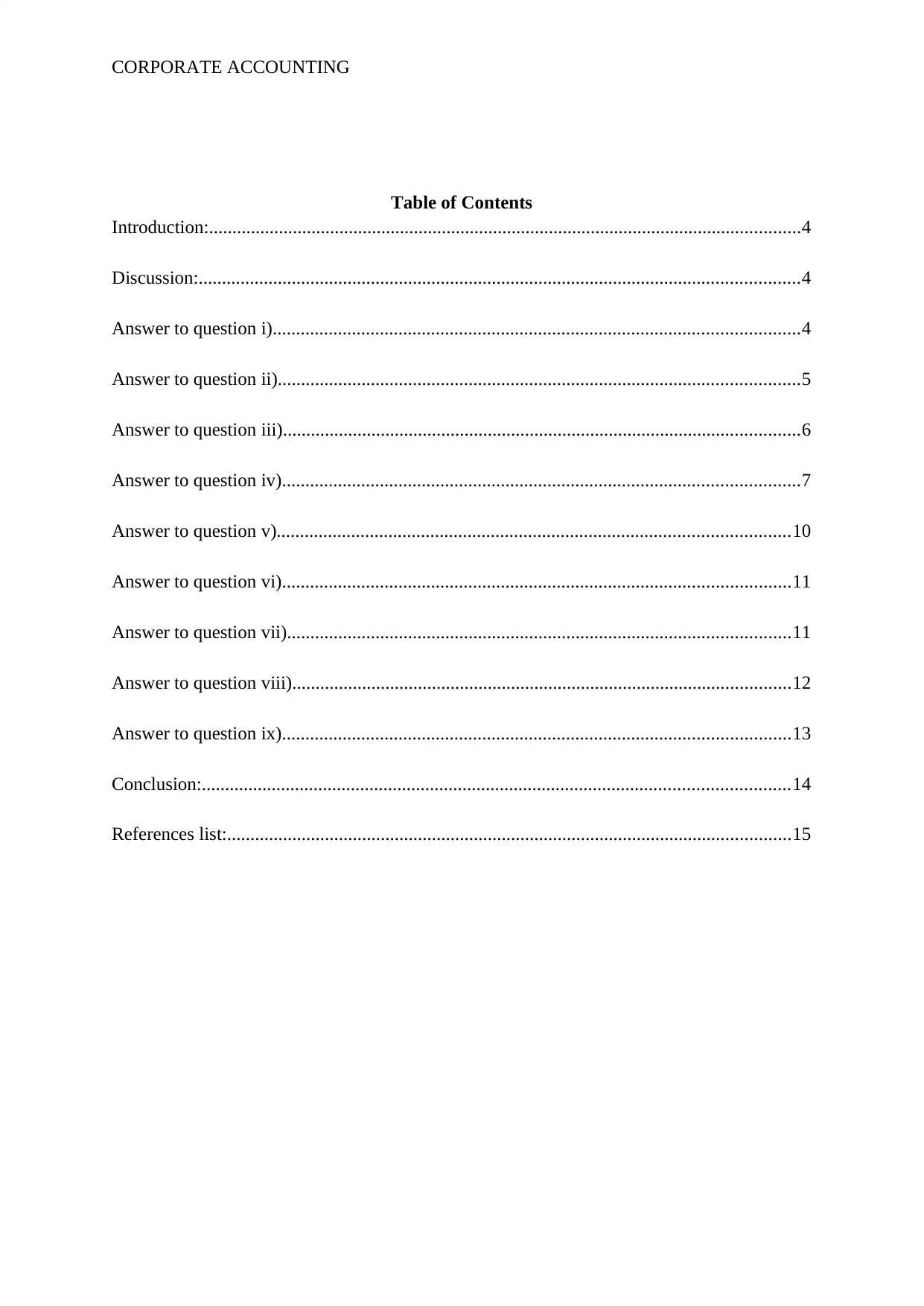
CORPORATE ACCOUNTING
Table of Contents
Introduction:...............................................................................................................................4
Discussion:.................................................................................................................................4
Answer to question i).................................................................................................................4
Answer to question ii)................................................................................................................5
Answer to question iii)...............................................................................................................6
Answer to question iv)...............................................................................................................7
Answer to question v)..............................................................................................................10
Answer to question vi).............................................................................................................11
Answer to question vii)............................................................................................................11
Answer to question viii)...........................................................................................................12
Answer to question ix).............................................................................................................13
Conclusion:..............................................................................................................................14
References list:.........................................................................................................................15
Table of Contents
Introduction:...............................................................................................................................4
Discussion:.................................................................................................................................4
Answer to question i).................................................................................................................4
Answer to question ii)................................................................................................................5
Answer to question iii)...............................................................................................................6
Answer to question iv)...............................................................................................................7
Answer to question v)..............................................................................................................10
Answer to question vi).............................................................................................................11
Answer to question vii)............................................................................................................11
Answer to question viii)...........................................................................................................12
Answer to question ix).............................................................................................................13
Conclusion:..............................................................................................................................14
References list:.........................................................................................................................15
⊘ This is a preview!⊘
Do you want full access?
Subscribe today to unlock all pages.

Trusted by 1+ million students worldwide
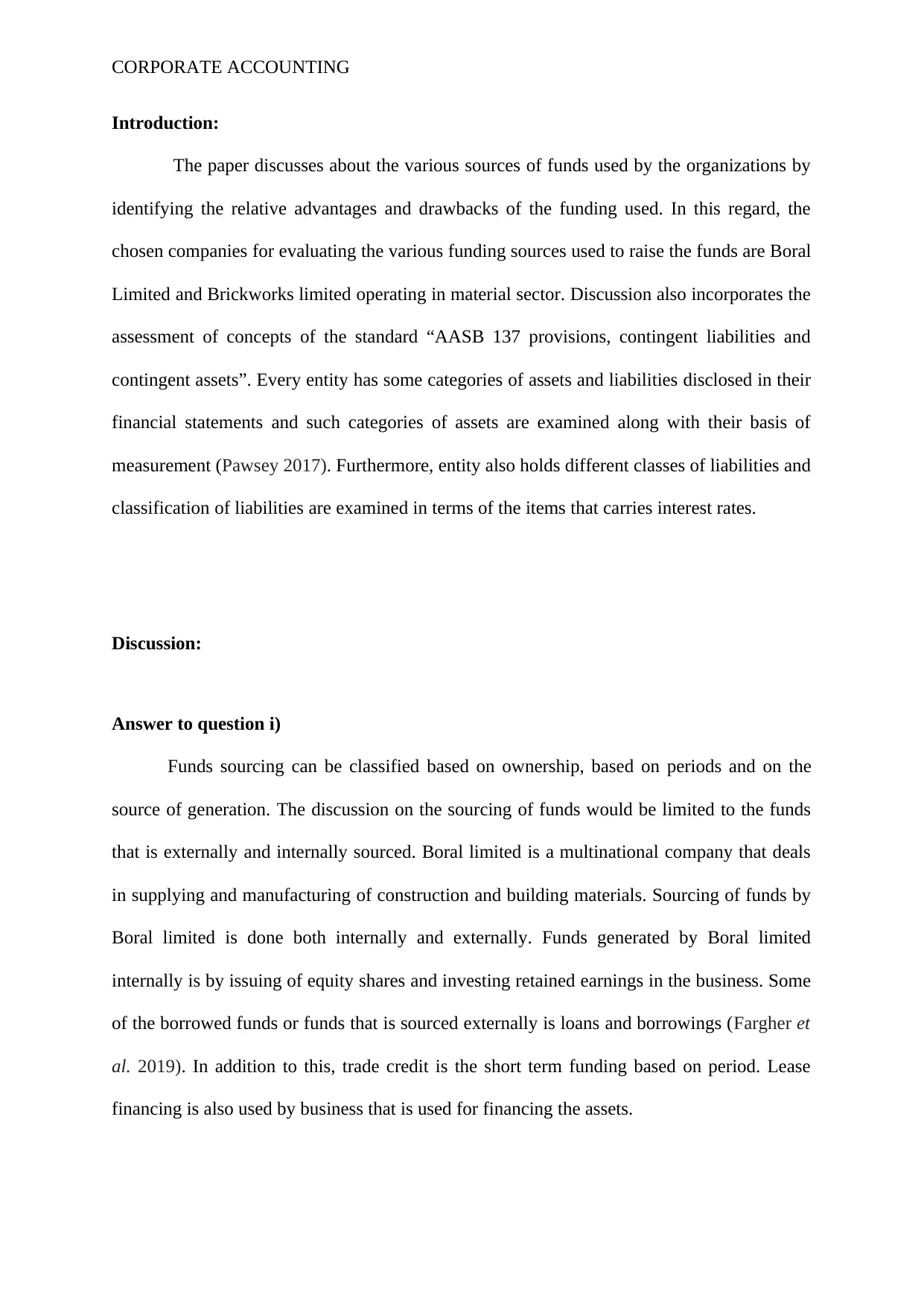
CORPORATE ACCOUNTING
Introduction:
The paper discusses about the various sources of funds used by the organizations by
identifying the relative advantages and drawbacks of the funding used. In this regard, the
chosen companies for evaluating the various funding sources used to raise the funds are Boral
Limited and Brickworks limited operating in material sector. Discussion also incorporates the
assessment of concepts of the standard “AASB 137 provisions, contingent liabilities and
contingent assets”. Every entity has some categories of assets and liabilities disclosed in their
financial statements and such categories of assets are examined along with their basis of
measurement (Pawsey 2017). Furthermore, entity also holds different classes of liabilities and
classification of liabilities are examined in terms of the items that carries interest rates.
Discussion:
Answer to question i)
Funds sourcing can be classified based on ownership, based on periods and on the
source of generation. The discussion on the sourcing of funds would be limited to the funds
that is externally and internally sourced. Boral limited is a multinational company that deals
in supplying and manufacturing of construction and building materials. Sourcing of funds by
Boral limited is done both internally and externally. Funds generated by Boral limited
internally is by issuing of equity shares and investing retained earnings in the business. Some
of the borrowed funds or funds that is sourced externally is loans and borrowings (Fargher et
al. 2019). In addition to this, trade credit is the short term funding based on period. Lease
financing is also used by business that is used for financing the assets.
Introduction:
The paper discusses about the various sources of funds used by the organizations by
identifying the relative advantages and drawbacks of the funding used. In this regard, the
chosen companies for evaluating the various funding sources used to raise the funds are Boral
Limited and Brickworks limited operating in material sector. Discussion also incorporates the
assessment of concepts of the standard “AASB 137 provisions, contingent liabilities and
contingent assets”. Every entity has some categories of assets and liabilities disclosed in their
financial statements and such categories of assets are examined along with their basis of
measurement (Pawsey 2017). Furthermore, entity also holds different classes of liabilities and
classification of liabilities are examined in terms of the items that carries interest rates.
Discussion:
Answer to question i)
Funds sourcing can be classified based on ownership, based on periods and on the
source of generation. The discussion on the sourcing of funds would be limited to the funds
that is externally and internally sourced. Boral limited is a multinational company that deals
in supplying and manufacturing of construction and building materials. Sourcing of funds by
Boral limited is done both internally and externally. Funds generated by Boral limited
internally is by issuing of equity shares and investing retained earnings in the business. Some
of the borrowed funds or funds that is sourced externally is loans and borrowings (Fargher et
al. 2019). In addition to this, trade credit is the short term funding based on period. Lease
financing is also used by business that is used for financing the assets.
Paraphrase This Document
Need a fresh take? Get an instant paraphrase of this document with our AI Paraphraser
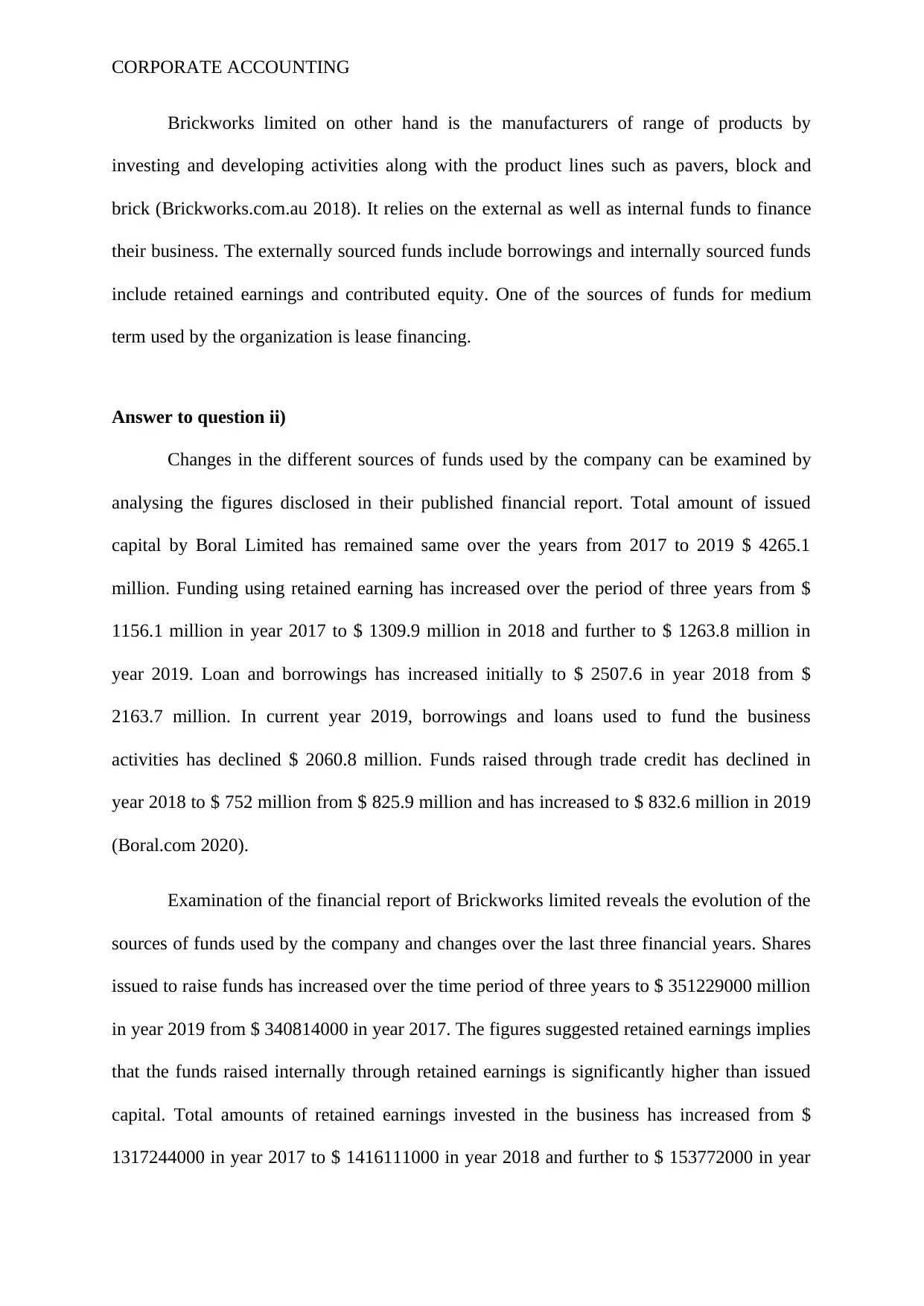
CORPORATE ACCOUNTING
Brickworks limited on other hand is the manufacturers of range of products by
investing and developing activities along with the product lines such as pavers, block and
brick (Brickworks.com.au 2018). It relies on the external as well as internal funds to finance
their business. The externally sourced funds include borrowings and internally sourced funds
include retained earnings and contributed equity. One of the sources of funds for medium
term used by the organization is lease financing.
Answer to question ii)
Changes in the different sources of funds used by the company can be examined by
analysing the figures disclosed in their published financial report. Total amount of issued
capital by Boral Limited has remained same over the years from 2017 to 2019 $ 4265.1
million. Funding using retained earning has increased over the period of three years from $
1156.1 million in year 2017 to $ 1309.9 million in 2018 and further to $ 1263.8 million in
year 2019. Loan and borrowings has increased initially to $ 2507.6 in year 2018 from $
2163.7 million. In current year 2019, borrowings and loans used to fund the business
activities has declined $ 2060.8 million. Funds raised through trade credit has declined in
year 2018 to $ 752 million from $ 825.9 million and has increased to $ 832.6 million in 2019
(Boral.com 2020).
Examination of the financial report of Brickworks limited reveals the evolution of the
sources of funds used by the company and changes over the last three financial years. Shares
issued to raise funds has increased over the time period of three years to $ 351229000 million
in year 2019 from $ 340814000 in year 2017. The figures suggested retained earnings implies
that the funds raised internally through retained earnings is significantly higher than issued
capital. Total amounts of retained earnings invested in the business has increased from $
1317244000 in year 2017 to $ 1416111000 in year 2018 and further to $ 153772000 in year
Brickworks limited on other hand is the manufacturers of range of products by
investing and developing activities along with the product lines such as pavers, block and
brick (Brickworks.com.au 2018). It relies on the external as well as internal funds to finance
their business. The externally sourced funds include borrowings and internally sourced funds
include retained earnings and contributed equity. One of the sources of funds for medium
term used by the organization is lease financing.
Answer to question ii)
Changes in the different sources of funds used by the company can be examined by
analysing the figures disclosed in their published financial report. Total amount of issued
capital by Boral Limited has remained same over the years from 2017 to 2019 $ 4265.1
million. Funding using retained earning has increased over the period of three years from $
1156.1 million in year 2017 to $ 1309.9 million in 2018 and further to $ 1263.8 million in
year 2019. Loan and borrowings has increased initially to $ 2507.6 in year 2018 from $
2163.7 million. In current year 2019, borrowings and loans used to fund the business
activities has declined $ 2060.8 million. Funds raised through trade credit has declined in
year 2018 to $ 752 million from $ 825.9 million and has increased to $ 832.6 million in 2019
(Boral.com 2020).
Examination of the financial report of Brickworks limited reveals the evolution of the
sources of funds used by the company and changes over the last three financial years. Shares
issued to raise funds has increased over the time period of three years to $ 351229000 million
in year 2019 from $ 340814000 in year 2017. The figures suggested retained earnings implies
that the funds raised internally through retained earnings is significantly higher than issued
capital. Total amounts of retained earnings invested in the business has increased from $
1317244000 in year 2017 to $ 1416111000 in year 2018 and further to $ 153772000 in year
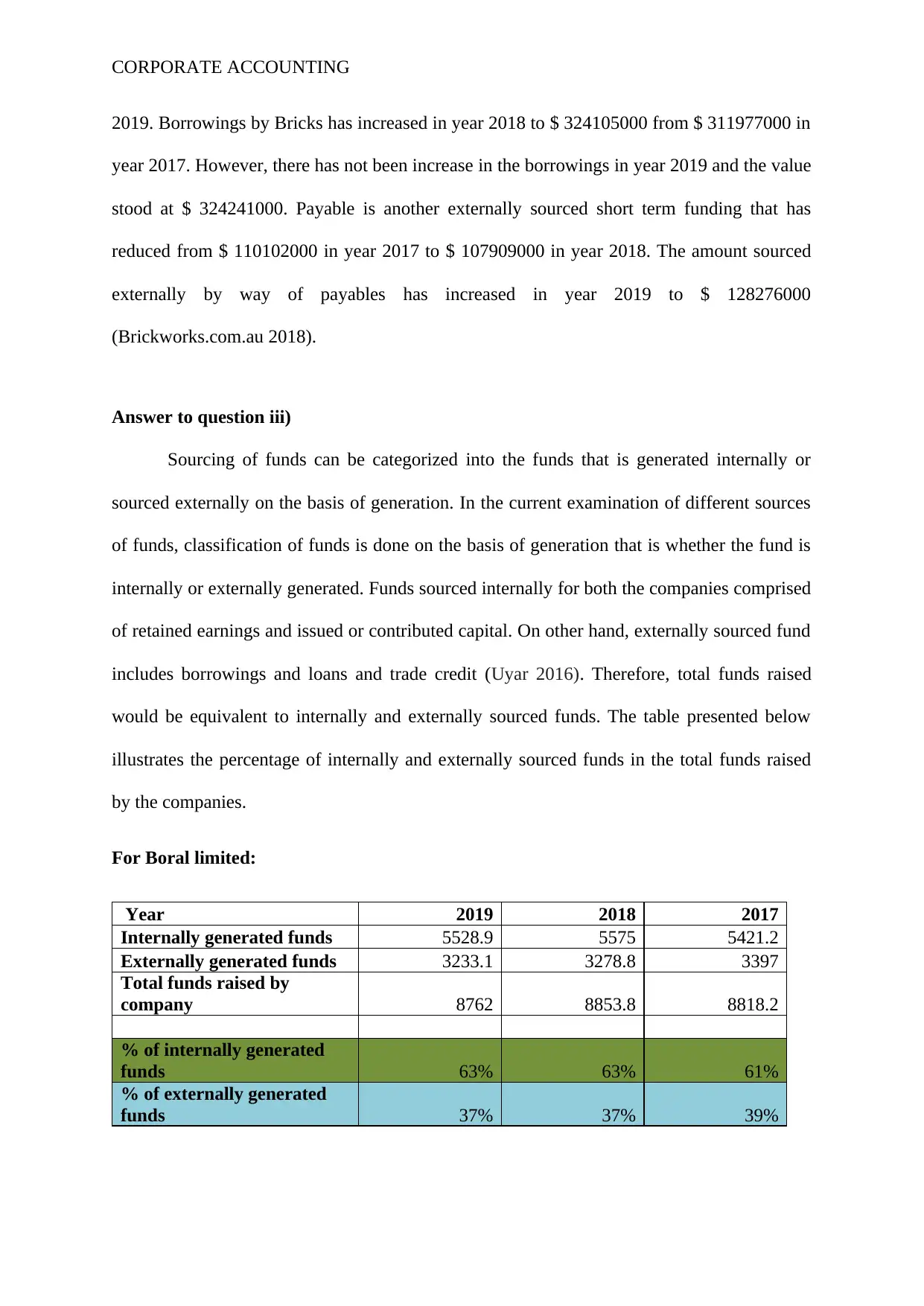
CORPORATE ACCOUNTING
2019. Borrowings by Bricks has increased in year 2018 to $ 324105000 from $ 311977000 in
year 2017. However, there has not been increase in the borrowings in year 2019 and the value
stood at $ 324241000. Payable is another externally sourced short term funding that has
reduced from $ 110102000 in year 2017 to $ 107909000 in year 2018. The amount sourced
externally by way of payables has increased in year 2019 to $ 128276000
(Brickworks.com.au 2018).
Answer to question iii)
Sourcing of funds can be categorized into the funds that is generated internally or
sourced externally on the basis of generation. In the current examination of different sources
of funds, classification of funds is done on the basis of generation that is whether the fund is
internally or externally generated. Funds sourced internally for both the companies comprised
of retained earnings and issued or contributed capital. On other hand, externally sourced fund
includes borrowings and loans and trade credit (Uyar 2016). Therefore, total funds raised
would be equivalent to internally and externally sourced funds. The table presented below
illustrates the percentage of internally and externally sourced funds in the total funds raised
by the companies.
For Boral limited:
Year 2019 2018 2017
Internally generated funds 5528.9 5575 5421.2
Externally generated funds 3233.1 3278.8 3397
Total funds raised by
company 8762 8853.8 8818.2
% of internally generated
funds 63% 63% 61%
% of externally generated
funds 37% 37% 39%
2019. Borrowings by Bricks has increased in year 2018 to $ 324105000 from $ 311977000 in
year 2017. However, there has not been increase in the borrowings in year 2019 and the value
stood at $ 324241000. Payable is another externally sourced short term funding that has
reduced from $ 110102000 in year 2017 to $ 107909000 in year 2018. The amount sourced
externally by way of payables has increased in year 2019 to $ 128276000
(Brickworks.com.au 2018).
Answer to question iii)
Sourcing of funds can be categorized into the funds that is generated internally or
sourced externally on the basis of generation. In the current examination of different sources
of funds, classification of funds is done on the basis of generation that is whether the fund is
internally or externally generated. Funds sourced internally for both the companies comprised
of retained earnings and issued or contributed capital. On other hand, externally sourced fund
includes borrowings and loans and trade credit (Uyar 2016). Therefore, total funds raised
would be equivalent to internally and externally sourced funds. The table presented below
illustrates the percentage of internally and externally sourced funds in the total funds raised
by the companies.
For Boral limited:
Year 2019 2018 2017
Internally generated funds 5528.9 5575 5421.2
Externally generated funds 3233.1 3278.8 3397
Total funds raised by
company 8762 8853.8 8818.2
% of internally generated
funds 63% 63% 61%
% of externally generated
funds 37% 37% 39%
⊘ This is a preview!⊘
Do you want full access?
Subscribe today to unlock all pages.

Trusted by 1+ million students worldwide
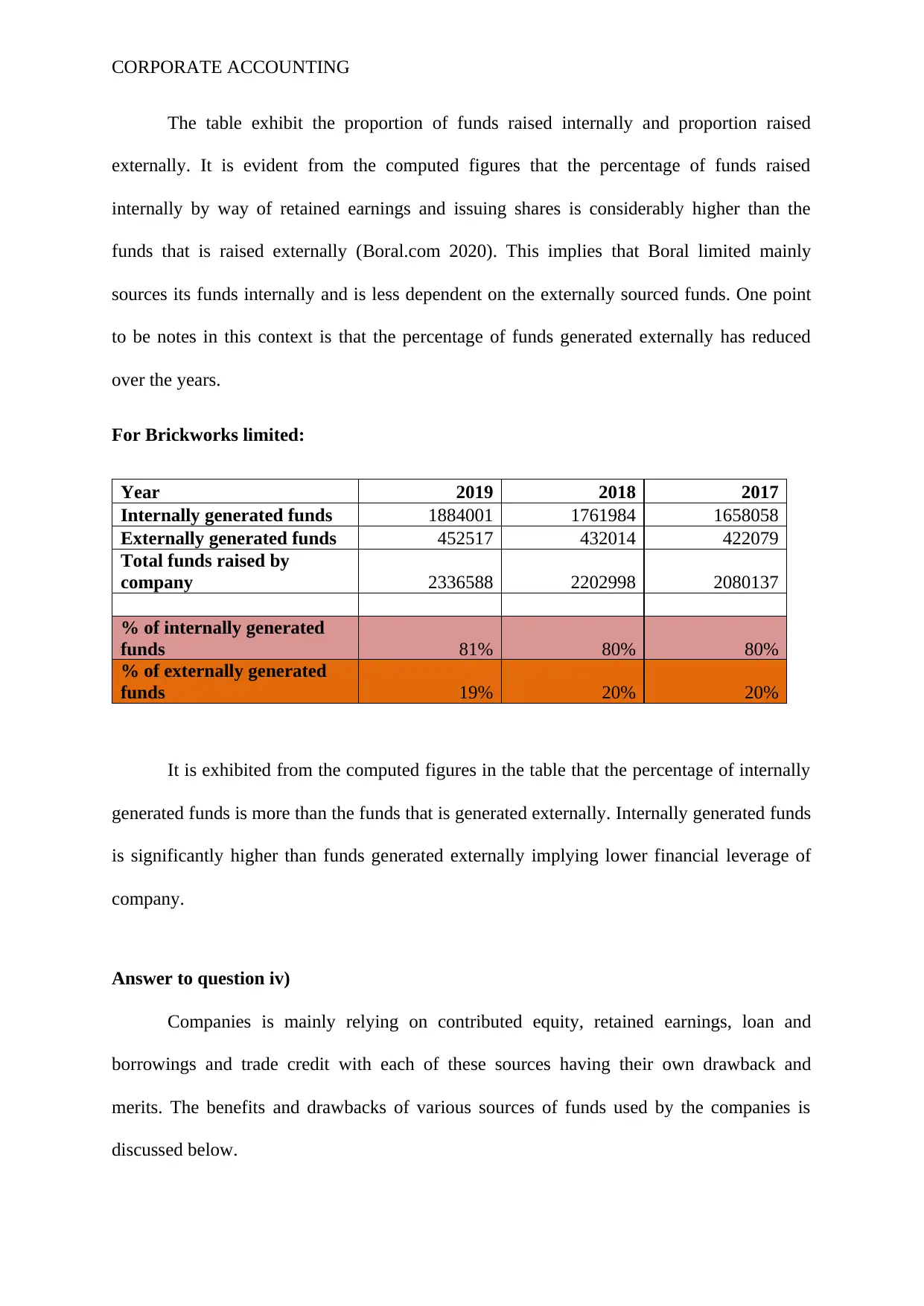
CORPORATE ACCOUNTING
The table exhibit the proportion of funds raised internally and proportion raised
externally. It is evident from the computed figures that the percentage of funds raised
internally by way of retained earnings and issuing shares is considerably higher than the
funds that is raised externally (Boral.com 2020). This implies that Boral limited mainly
sources its funds internally and is less dependent on the externally sourced funds. One point
to be notes in this context is that the percentage of funds generated externally has reduced
over the years.
For Brickworks limited:
Year 2019 2018 2017
Internally generated funds 1884001 1761984 1658058
Externally generated funds 452517 432014 422079
Total funds raised by
company 2336588 2202998 2080137
% of internally generated
funds 81% 80% 80%
% of externally generated
funds 19% 20% 20%
It is exhibited from the computed figures in the table that the percentage of internally
generated funds is more than the funds that is generated externally. Internally generated funds
is significantly higher than funds generated externally implying lower financial leverage of
company.
Answer to question iv)
Companies is mainly relying on contributed equity, retained earnings, loan and
borrowings and trade credit with each of these sources having their own drawback and
merits. The benefits and drawbacks of various sources of funds used by the companies is
discussed below.
The table exhibit the proportion of funds raised internally and proportion raised
externally. It is evident from the computed figures that the percentage of funds raised
internally by way of retained earnings and issuing shares is considerably higher than the
funds that is raised externally (Boral.com 2020). This implies that Boral limited mainly
sources its funds internally and is less dependent on the externally sourced funds. One point
to be notes in this context is that the percentage of funds generated externally has reduced
over the years.
For Brickworks limited:
Year 2019 2018 2017
Internally generated funds 1884001 1761984 1658058
Externally generated funds 452517 432014 422079
Total funds raised by
company 2336588 2202998 2080137
% of internally generated
funds 81% 80% 80%
% of externally generated
funds 19% 20% 20%
It is exhibited from the computed figures in the table that the percentage of internally
generated funds is more than the funds that is generated externally. Internally generated funds
is significantly higher than funds generated externally implying lower financial leverage of
company.
Answer to question iv)
Companies is mainly relying on contributed equity, retained earnings, loan and
borrowings and trade credit with each of these sources having their own drawback and
merits. The benefits and drawbacks of various sources of funds used by the companies is
discussed below.
Paraphrase This Document
Need a fresh take? Get an instant paraphrase of this document with our AI Paraphraser
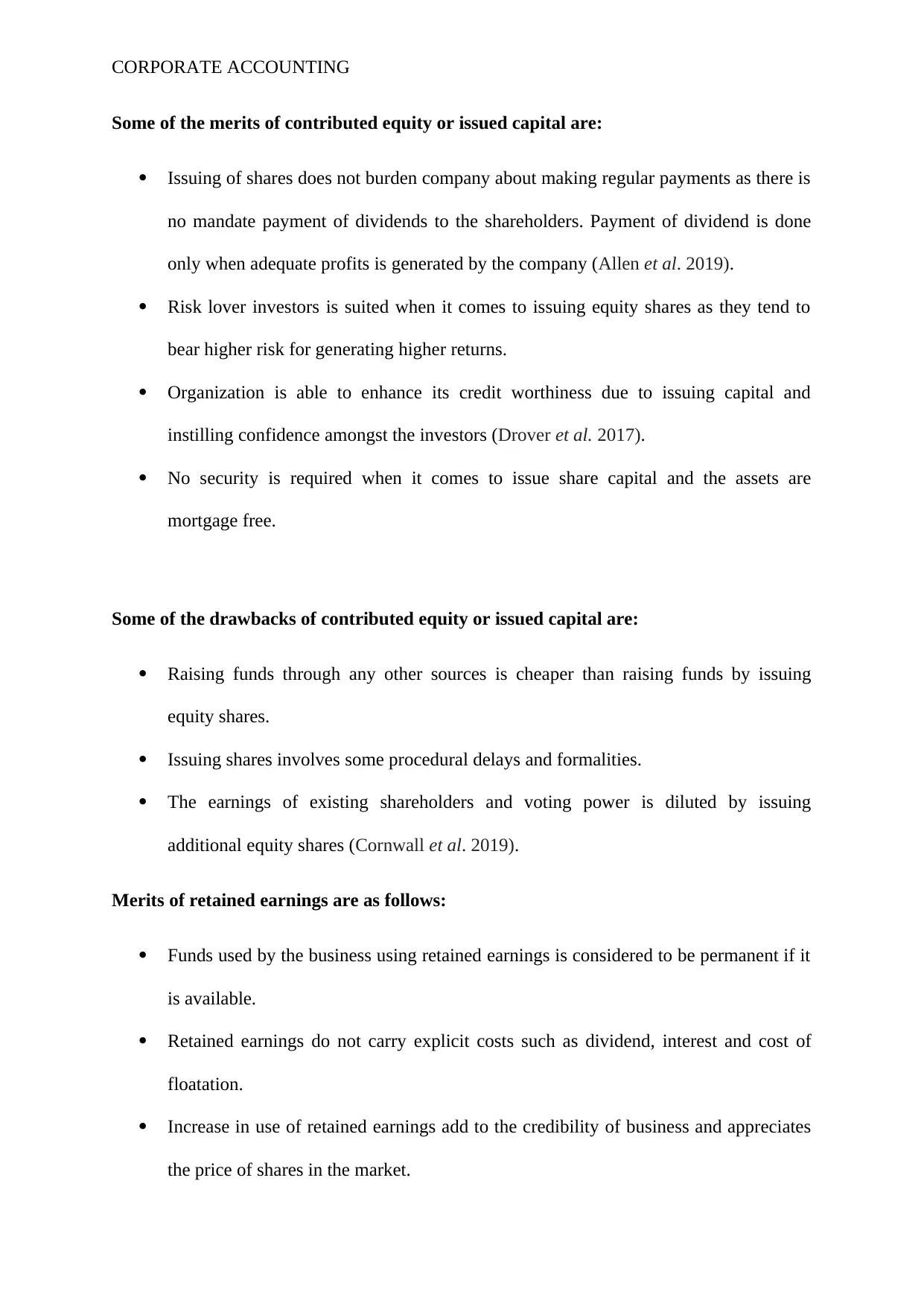
CORPORATE ACCOUNTING
Some of the merits of contributed equity or issued capital are:
Issuing of shares does not burden company about making regular payments as there is
no mandate payment of dividends to the shareholders. Payment of dividend is done
only when adequate profits is generated by the company (Allen et al. 2019).
Risk lover investors is suited when it comes to issuing equity shares as they tend to
bear higher risk for generating higher returns.
Organization is able to enhance its credit worthiness due to issuing capital and
instilling confidence amongst the investors (Drover et al. 2017).
No security is required when it comes to issue share capital and the assets are
mortgage free.
Some of the drawbacks of contributed equity or issued capital are:
Raising funds through any other sources is cheaper than raising funds by issuing
equity shares.
Issuing shares involves some procedural delays and formalities.
The earnings of existing shareholders and voting power is diluted by issuing
additional equity shares (Cornwall et al. 2019).
Merits of retained earnings are as follows:
Funds used by the business using retained earnings is considered to be permanent if it
is available.
Retained earnings do not carry explicit costs such as dividend, interest and cost of
floatation.
Increase in use of retained earnings add to the credibility of business and appreciates
the price of shares in the market.
Some of the merits of contributed equity or issued capital are:
Issuing of shares does not burden company about making regular payments as there is
no mandate payment of dividends to the shareholders. Payment of dividend is done
only when adequate profits is generated by the company (Allen et al. 2019).
Risk lover investors is suited when it comes to issuing equity shares as they tend to
bear higher risk for generating higher returns.
Organization is able to enhance its credit worthiness due to issuing capital and
instilling confidence amongst the investors (Drover et al. 2017).
No security is required when it comes to issue share capital and the assets are
mortgage free.
Some of the drawbacks of contributed equity or issued capital are:
Raising funds through any other sources is cheaper than raising funds by issuing
equity shares.
Issuing shares involves some procedural delays and formalities.
The earnings of existing shareholders and voting power is diluted by issuing
additional equity shares (Cornwall et al. 2019).
Merits of retained earnings are as follows:
Funds used by the business using retained earnings is considered to be permanent if it
is available.
Retained earnings do not carry explicit costs such as dividend, interest and cost of
floatation.
Increase in use of retained earnings add to the credibility of business and appreciates
the price of shares in the market.
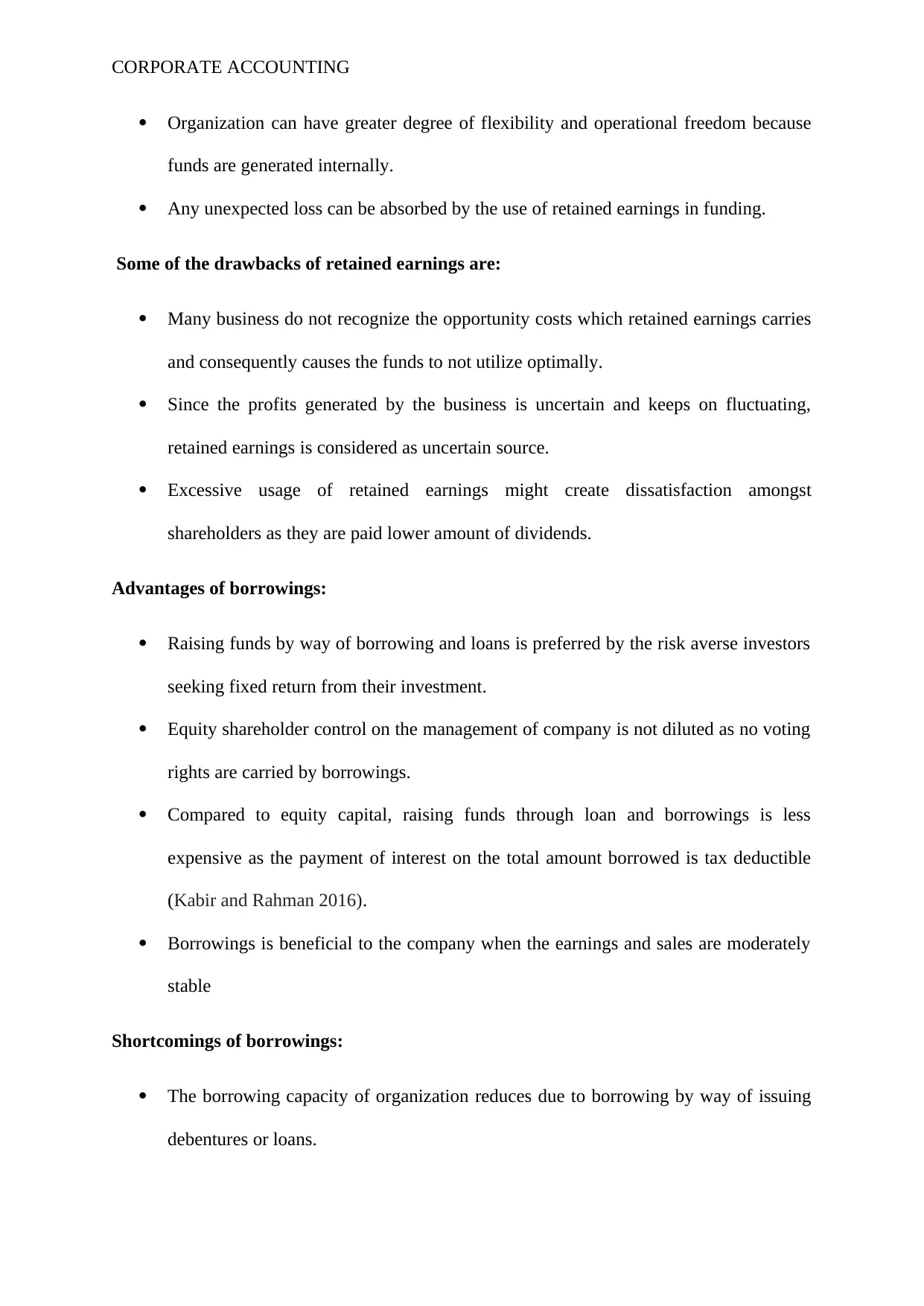
CORPORATE ACCOUNTING
Organization can have greater degree of flexibility and operational freedom because
funds are generated internally.
Any unexpected loss can be absorbed by the use of retained earnings in funding.
Some of the drawbacks of retained earnings are:
Many business do not recognize the opportunity costs which retained earnings carries
and consequently causes the funds to not utilize optimally.
Since the profits generated by the business is uncertain and keeps on fluctuating,
retained earnings is considered as uncertain source.
Excessive usage of retained earnings might create dissatisfaction amongst
shareholders as they are paid lower amount of dividends.
Advantages of borrowings:
Raising funds by way of borrowing and loans is preferred by the risk averse investors
seeking fixed return from their investment.
Equity shareholder control on the management of company is not diluted as no voting
rights are carried by borrowings.
Compared to equity capital, raising funds through loan and borrowings is less
expensive as the payment of interest on the total amount borrowed is tax deductible
(Kabir and Rahman 2016).
Borrowings is beneficial to the company when the earnings and sales are moderately
stable
Shortcomings of borrowings:
The borrowing capacity of organization reduces due to borrowing by way of issuing
debentures or loans.
Organization can have greater degree of flexibility and operational freedom because
funds are generated internally.
Any unexpected loss can be absorbed by the use of retained earnings in funding.
Some of the drawbacks of retained earnings are:
Many business do not recognize the opportunity costs which retained earnings carries
and consequently causes the funds to not utilize optimally.
Since the profits generated by the business is uncertain and keeps on fluctuating,
retained earnings is considered as uncertain source.
Excessive usage of retained earnings might create dissatisfaction amongst
shareholders as they are paid lower amount of dividends.
Advantages of borrowings:
Raising funds by way of borrowing and loans is preferred by the risk averse investors
seeking fixed return from their investment.
Equity shareholder control on the management of company is not diluted as no voting
rights are carried by borrowings.
Compared to equity capital, raising funds through loan and borrowings is less
expensive as the payment of interest on the total amount borrowed is tax deductible
(Kabir and Rahman 2016).
Borrowings is beneficial to the company when the earnings and sales are moderately
stable
Shortcomings of borrowings:
The borrowing capacity of organization reduces due to borrowing by way of issuing
debentures or loans.
⊘ This is a preview!⊘
Do you want full access?
Subscribe today to unlock all pages.

Trusted by 1+ million students worldwide
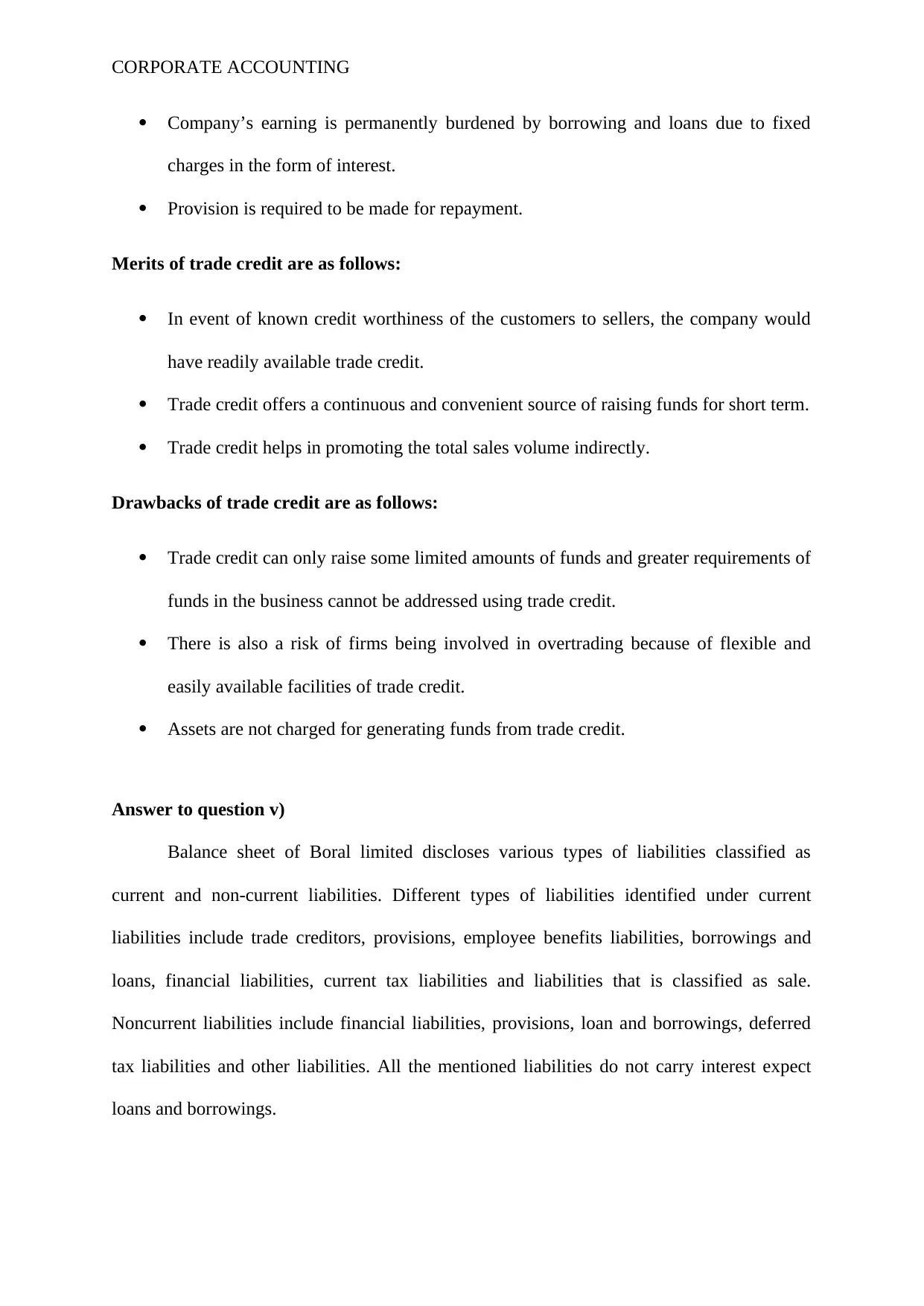
CORPORATE ACCOUNTING
Company’s earning is permanently burdened by borrowing and loans due to fixed
charges in the form of interest.
Provision is required to be made for repayment.
Merits of trade credit are as follows:
In event of known credit worthiness of the customers to sellers, the company would
have readily available trade credit.
Trade credit offers a continuous and convenient source of raising funds for short term.
Trade credit helps in promoting the total sales volume indirectly.
Drawbacks of trade credit are as follows:
Trade credit can only raise some limited amounts of funds and greater requirements of
funds in the business cannot be addressed using trade credit.
There is also a risk of firms being involved in overtrading because of flexible and
easily available facilities of trade credit.
Assets are not charged for generating funds from trade credit.
Answer to question v)
Balance sheet of Boral limited discloses various types of liabilities classified as
current and non-current liabilities. Different types of liabilities identified under current
liabilities include trade creditors, provisions, employee benefits liabilities, borrowings and
loans, financial liabilities, current tax liabilities and liabilities that is classified as sale.
Noncurrent liabilities include financial liabilities, provisions, loan and borrowings, deferred
tax liabilities and other liabilities. All the mentioned liabilities do not carry interest expect
loans and borrowings.
Company’s earning is permanently burdened by borrowing and loans due to fixed
charges in the form of interest.
Provision is required to be made for repayment.
Merits of trade credit are as follows:
In event of known credit worthiness of the customers to sellers, the company would
have readily available trade credit.
Trade credit offers a continuous and convenient source of raising funds for short term.
Trade credit helps in promoting the total sales volume indirectly.
Drawbacks of trade credit are as follows:
Trade credit can only raise some limited amounts of funds and greater requirements of
funds in the business cannot be addressed using trade credit.
There is also a risk of firms being involved in overtrading because of flexible and
easily available facilities of trade credit.
Assets are not charged for generating funds from trade credit.
Answer to question v)
Balance sheet of Boral limited discloses various types of liabilities classified as
current and non-current liabilities. Different types of liabilities identified under current
liabilities include trade creditors, provisions, employee benefits liabilities, borrowings and
loans, financial liabilities, current tax liabilities and liabilities that is classified as sale.
Noncurrent liabilities include financial liabilities, provisions, loan and borrowings, deferred
tax liabilities and other liabilities. All the mentioned liabilities do not carry interest expect
loans and borrowings.
Paraphrase This Document
Need a fresh take? Get an instant paraphrase of this document with our AI Paraphraser
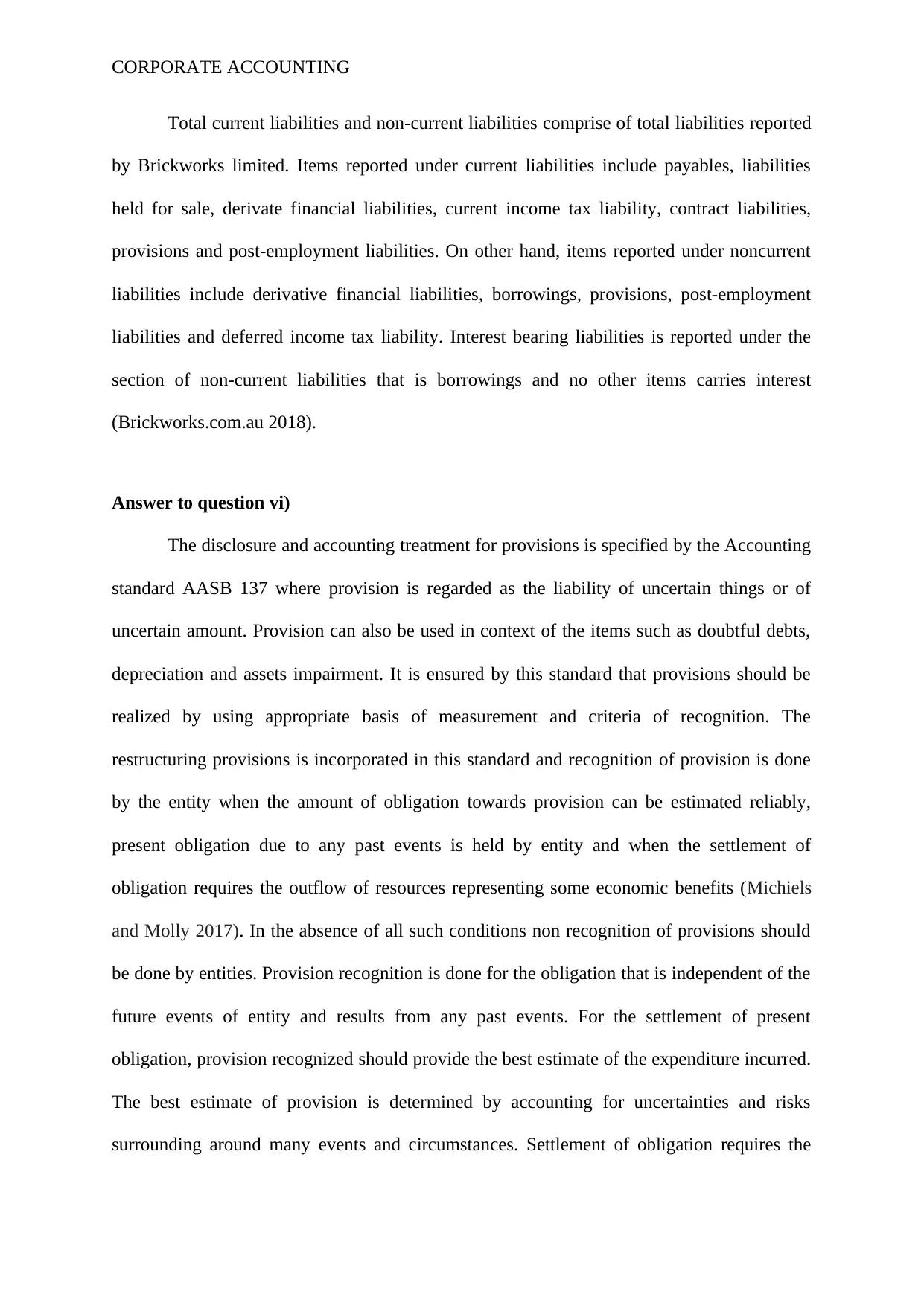
CORPORATE ACCOUNTING
Total current liabilities and non-current liabilities comprise of total liabilities reported
by Brickworks limited. Items reported under current liabilities include payables, liabilities
held for sale, derivate financial liabilities, current income tax liability, contract liabilities,
provisions and post-employment liabilities. On other hand, items reported under noncurrent
liabilities include derivative financial liabilities, borrowings, provisions, post-employment
liabilities and deferred income tax liability. Interest bearing liabilities is reported under the
section of non-current liabilities that is borrowings and no other items carries interest
(Brickworks.com.au 2018).
Answer to question vi)
The disclosure and accounting treatment for provisions is specified by the Accounting
standard AASB 137 where provision is regarded as the liability of uncertain things or of
uncertain amount. Provision can also be used in context of the items such as doubtful debts,
depreciation and assets impairment. It is ensured by this standard that provisions should be
realized by using appropriate basis of measurement and criteria of recognition. The
restructuring provisions is incorporated in this standard and recognition of provision is done
by the entity when the amount of obligation towards provision can be estimated reliably,
present obligation due to any past events is held by entity and when the settlement of
obligation requires the outflow of resources representing some economic benefits (Michiels
and Molly 2017). In the absence of all such conditions non recognition of provisions should
be done by entities. Provision recognition is done for the obligation that is independent of the
future events of entity and results from any past events. For the settlement of present
obligation, provision recognized should provide the best estimate of the expenditure incurred.
The best estimate of provision is determined by accounting for uncertainties and risks
surrounding around many events and circumstances. Settlement of obligation requires the
Total current liabilities and non-current liabilities comprise of total liabilities reported
by Brickworks limited. Items reported under current liabilities include payables, liabilities
held for sale, derivate financial liabilities, current income tax liability, contract liabilities,
provisions and post-employment liabilities. On other hand, items reported under noncurrent
liabilities include derivative financial liabilities, borrowings, provisions, post-employment
liabilities and deferred income tax liability. Interest bearing liabilities is reported under the
section of non-current liabilities that is borrowings and no other items carries interest
(Brickworks.com.au 2018).
Answer to question vi)
The disclosure and accounting treatment for provisions is specified by the Accounting
standard AASB 137 where provision is regarded as the liability of uncertain things or of
uncertain amount. Provision can also be used in context of the items such as doubtful debts,
depreciation and assets impairment. It is ensured by this standard that provisions should be
realized by using appropriate basis of measurement and criteria of recognition. The
restructuring provisions is incorporated in this standard and recognition of provision is done
by the entity when the amount of obligation towards provision can be estimated reliably,
present obligation due to any past events is held by entity and when the settlement of
obligation requires the outflow of resources representing some economic benefits (Michiels
and Molly 2017). In the absence of all such conditions non recognition of provisions should
be done by entities. Provision recognition is done for the obligation that is independent of the
future events of entity and results from any past events. For the settlement of present
obligation, provision recognized should provide the best estimate of the expenditure incurred.
The best estimate of provision is determined by accounting for uncertainties and risks
surrounding around many events and circumstances. Settlement of obligation requires the
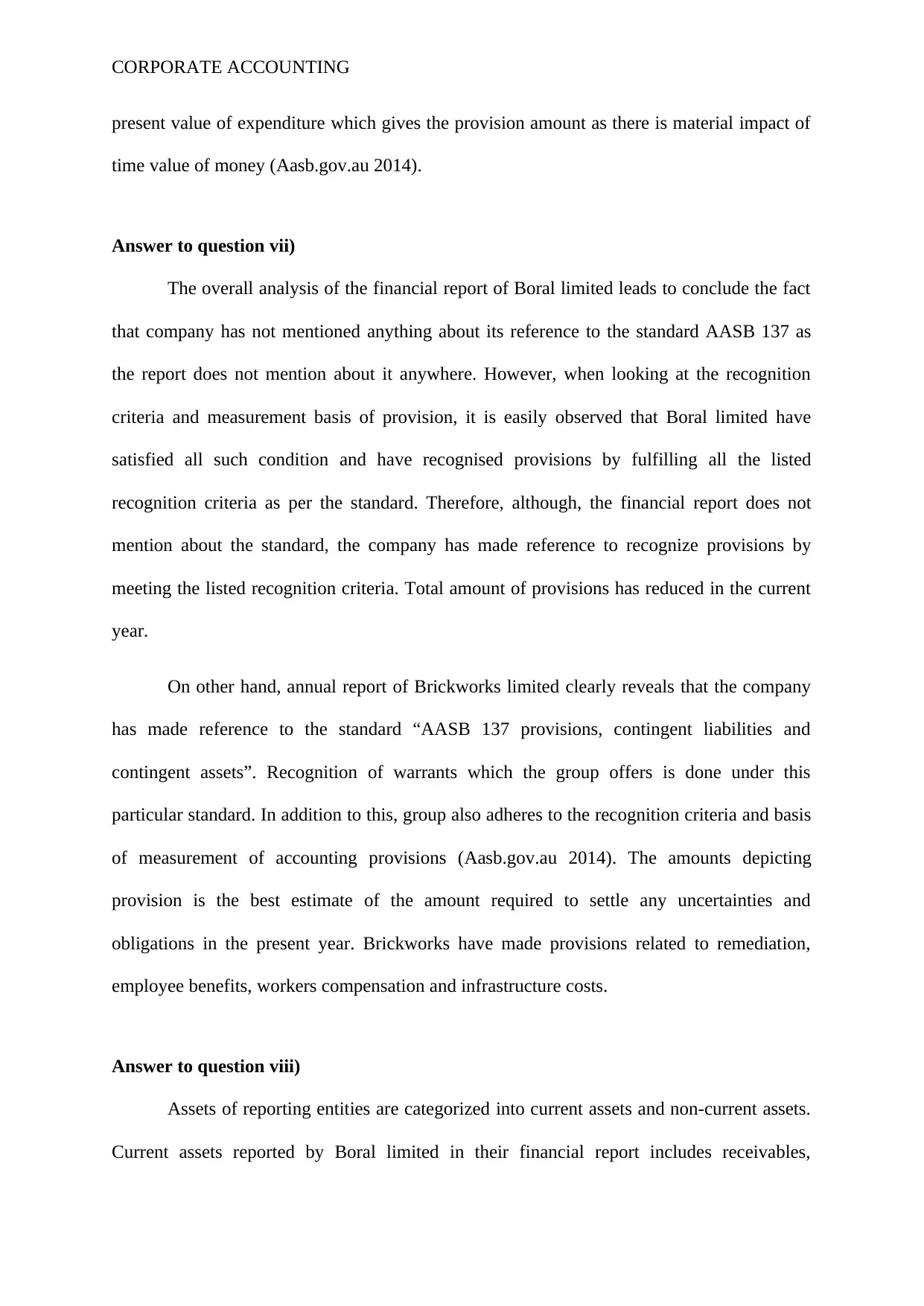
CORPORATE ACCOUNTING
present value of expenditure which gives the provision amount as there is material impact of
time value of money (Aasb.gov.au 2014).
Answer to question vii)
The overall analysis of the financial report of Boral limited leads to conclude the fact
that company has not mentioned anything about its reference to the standard AASB 137 as
the report does not mention about it anywhere. However, when looking at the recognition
criteria and measurement basis of provision, it is easily observed that Boral limited have
satisfied all such condition and have recognised provisions by fulfilling all the listed
recognition criteria as per the standard. Therefore, although, the financial report does not
mention about the standard, the company has made reference to recognize provisions by
meeting the listed recognition criteria. Total amount of provisions has reduced in the current
year.
On other hand, annual report of Brickworks limited clearly reveals that the company
has made reference to the standard “AASB 137 provisions, contingent liabilities and
contingent assets”. Recognition of warrants which the group offers is done under this
particular standard. In addition to this, group also adheres to the recognition criteria and basis
of measurement of accounting provisions (Aasb.gov.au 2014). The amounts depicting
provision is the best estimate of the amount required to settle any uncertainties and
obligations in the present year. Brickworks have made provisions related to remediation,
employee benefits, workers compensation and infrastructure costs.
Answer to question viii)
Assets of reporting entities are categorized into current assets and non-current assets.
Current assets reported by Boral limited in their financial report includes receivables,
present value of expenditure which gives the provision amount as there is material impact of
time value of money (Aasb.gov.au 2014).
Answer to question vii)
The overall analysis of the financial report of Boral limited leads to conclude the fact
that company has not mentioned anything about its reference to the standard AASB 137 as
the report does not mention about it anywhere. However, when looking at the recognition
criteria and measurement basis of provision, it is easily observed that Boral limited have
satisfied all such condition and have recognised provisions by fulfilling all the listed
recognition criteria as per the standard. Therefore, although, the financial report does not
mention about the standard, the company has made reference to recognize provisions by
meeting the listed recognition criteria. Total amount of provisions has reduced in the current
year.
On other hand, annual report of Brickworks limited clearly reveals that the company
has made reference to the standard “AASB 137 provisions, contingent liabilities and
contingent assets”. Recognition of warrants which the group offers is done under this
particular standard. In addition to this, group also adheres to the recognition criteria and basis
of measurement of accounting provisions (Aasb.gov.au 2014). The amounts depicting
provision is the best estimate of the amount required to settle any uncertainties and
obligations in the present year. Brickworks have made provisions related to remediation,
employee benefits, workers compensation and infrastructure costs.
Answer to question viii)
Assets of reporting entities are categorized into current assets and non-current assets.
Current assets reported by Boral limited in their financial report includes receivables,
⊘ This is a preview!⊘
Do you want full access?
Subscribe today to unlock all pages.

Trusted by 1+ million students worldwide
1 out of 22
Related Documents
Your All-in-One AI-Powered Toolkit for Academic Success.
+13062052269
info@desklib.com
Available 24*7 on WhatsApp / Email
![[object Object]](/_next/static/media/star-bottom.7253800d.svg)
Unlock your academic potential
Copyright © 2020–2025 A2Z Services. All Rights Reserved. Developed and managed by ZUCOL.





